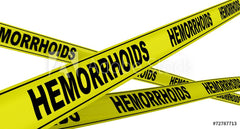Discover the Signs of Hemorrhoids for Pregnancy, Internal, External and Thrombosed
Posted on 17 March 2018 by Maryanne Johnson
Share this post
In this post we will discuss the most common signs of hemorrhoids so you know what to watch out for. Plus, we'll discuss some simple, easy steps you can take to get relief.
While the topic of hemorrhoids may seem like something your grandparents may complain about, this is actually not the case.
Hemorrhoids are one of the leading causes of discomfort experienced by adults over the age of 50 and are a common issue for pregnant women as well.
Early Signs of Hemorrhoids
One of the most sure-fire ways to tell if you are suffering from hemorrhoids is by checking to see if you are bleeding after a bowel movement.
Dabbing toilet paper gently on the rectal area and checking the toilet bowel for signs of bleeding will indicate if the veins of the lower rectum are inflamed, causing hemorrhoids.
Another early indicator aside from bleeding is straining during a bowel movement.
Straining or pushing during bowel movement do not mean that you have hemorrhoids but are evidence that your body isn’t getting enough fiber, which can result in the formation of hemorrhoids.
Hopefully by listening to your body and understanding what it needs you can prevent a flare-up of hemorrhoids from occurring.
Signs of Internal Hemorrhoids
Internal hemorrhoids materialize far enough up in the cavity of the rectum that they are typically painless.
This area of the rectum contains veins that can become inflamed, but this is hardly felt because there is an absence of pain-sensing nerves.
Perhaps the only sign of internal hemorrhoids is the painless bleeding. While bleeding can be alarming, know that hemorrhoids usually disappear by themselves after a few days.
Just be sure to give your body plenty of fiber in your diet in order to prevent internal hemorrhoids from happening.
Signs of External Hemorrhoids
External hemorrhoids are the more painful of the two types. These hemorrhoids form underneath the skin around the outside of the anus and unlike its internal counterpart, we do have pain-sensing nerves in this area.
Not only do external hemorrhoids cause pain, but they will also bleed. The pain intensifies during strained bowel movements and sometimes, the formation of a blood clot will occur, also known as thrombosis.

Physical signs of the presence of external hemorrhoids include bumps around the anal sphincter.
These bumps are sensitive to the touch and often hurt during a bowel movement. Thrombosis manifests in these bumps and can turn purple or blue in color.
How Pregnancy Can Cause Hemorrhoids
Hemorrhoids are more likely to occur when a considerable amount of weight has been gained.
Weight gain adds stress on the body, including the lower rectal area, affecting blood flow and causing the veins in this area to swell.
Weight gain and pregnancy are synonymous. Even if a pregnant woman doesn’t end up gaining a ton of extra weight after her pregnancy, the duration of her pregnancy is another story.
Her body will still need to expand and accommodate for the fetus and its weight throughout the terms, and this additional weight is a sizable stressor for her body.
During pregnancy, the uterus expands for the growing fetus.
This puts pressure on the pelvic region, including the inferior vena cava, a large vein that helps transport blood to the legs and lower half of the body.
The slowing of the blood flow combined with the additional pressure can cause rectal veins to swell, resulting in hemorrhoids.
Other conditions that take place during a pregnancy like constipation and the production of progesterone (which relaxes the veins, in turn causing them to swell easier), which can also result in the formation of hemorrhoids.
Signs of Hemorrhoids During Pregnancy
Whether or not you are pregnant, the signs of hemorrhoids will remain the same:
- Irritation or itchiness around the outside of the anal sphincter
- Bleeding after a bowel movement
- Bumps around the anus that are moist, pink or blue in color
- Bumps that produce painful bleeding and are sensitive to the touch
- Straining and pushing during a bowel movement
- Constipation
When Are Hemorrhoids Most Common?
Hemorrhoids are more common in the third trimester of pregnancy.
Hemorrhoids also tend to be more frequent during the actual labor process, due to the straining and pushing.
Many women experience hemorrhoids directly after giving birth, in the early days of their postpartum period.
Preventative Methods for Hemorrhoids
There are plenty of active steps you can take to prevent hemorrhoids.
Many of these methods should be absorbed into your daily routine in order to maintain a healthy lifestyle.
- Fiber: a diet high in fruits and vegetables will promote healthy bowel movements, and in turn, prevent hemorrhoids.
- Hydration: for pregnant women and people over the age of 50, staying hydrated is important in the prevention of hemorrhoids.
- Exercise: having an appropriate amount of exercise in your day-to-day routine will promote circulation, help you maintain a healthy weight, and the overall health of your internal organs.
While hemorrhoids usually go away within a few days without medication, following these 3 simple steps will curb the onset of hemorrhoids in the future.
We hope you can now detect the most common signs of hemorrhoids.





0 comments